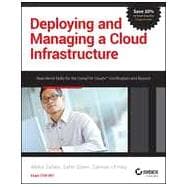Deploying and Managing a Cloud Infrastructure is an excellent resource for IT professionals seeking to tap into the demand for cloud administrators. This book helps prepare candidates for the CompTIA Cloud+ Certification (CV0-001) cloud computing certification exam. Designed for IT professionals with 2-3 years of networking experience, this certification provides validation of your cloud infrastructure knowledge.
With over 30 years of combined experience in cloud computing, the author team provides the latest expert perspectives on enterprise-level mobile computing, and covers the most essential topics for building and maintaining cloud-based systems, including:
- Understanding basic cloud-related computing concepts, terminology, and characteristics
- Identifying cloud delivery solutions and deploying new infrastructure
- Managing cloud technologies, services, and networks
- Monitoring hardware and software performance
Featuring real-world examples and interactive exercises, Deploying and Managing Cloud Infrastructure delivers practical knowledge you can apply immediately. And, in addition, you also get access to a full set of electronic study tools including:
- Interactive Test Environment
- Electronic Flashcards
- Glossary of Key Terms
Now is the time to learn the cloud computing skills you need to take that next step in your IT career.








